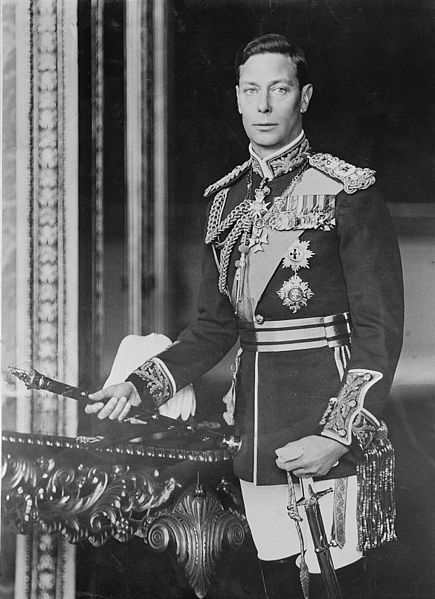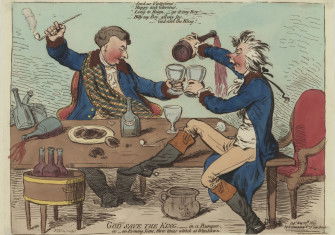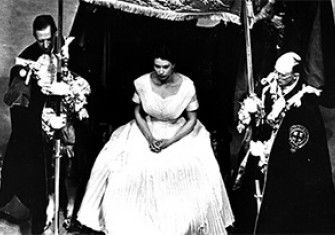The Funeral of King George VI
Richard Cavendish describes the King's funeral on 15 February 1952.
 On January 31st, looking tired and frail four months after an operation for lung cancer, the King waved goodbye to Princess Elizabeth and the Duke of Edinburgh at London Airport as they set off to East Africa. His doctors had kept the truth of his condition from him and though his family knew, they had to go through the motions. He went up to Sandringham in Norfolk and went out hare-shooting in a cheerful frame of mind with a group of friends on a bright, cold day on February 5th. After planning the next day’s sport the King went up to bed about 10.30 that night, went to sleep around midnight and never woke up. Early the next morning he was found dead in bed of a coronary thrombosis. He was fifty-six years old and had been King for fifteen years, since December 1936, in which time, shy and stammering and unprepared, he had earned considerable respect and affection.
On January 31st, looking tired and frail four months after an operation for lung cancer, the King waved goodbye to Princess Elizabeth and the Duke of Edinburgh at London Airport as they set off to East Africa. His doctors had kept the truth of his condition from him and though his family knew, they had to go through the motions. He went up to Sandringham in Norfolk and went out hare-shooting in a cheerful frame of mind with a group of friends on a bright, cold day on February 5th. After planning the next day’s sport the King went up to bed about 10.30 that night, went to sleep around midnight and never woke up. Early the next morning he was found dead in bed of a coronary thrombosis. He was fifty-six years old and had been King for fifteen years, since December 1936, in which time, shy and stammering and unprepared, he had earned considerable respect and affection.
The new queen and her husband returned from Africa at once. On February 11th the late King’ s coffin was moved from the church at Sandringham to Westminster Hall in London to lie in state while more than 300,000 people filed past. Foreign royalties and heads of state gathered in London for the funeral. The King’ s elder brother and predecessor, the Duke of Windsor, arrived at Southampton on the 13th aboard the Queen Mary. He did not bring his duchess, who had not been invited, but he brought his grievances. The palace had been in no particular hurry to inform him of his brother’ s passing and he had first heard of it from journalists demanding a statement at the Waldorf Towers in New York, where he was seeing the winter through.
In London he stayed with his mother, the eighty-five-year-old Queen Mary at Marlborough House. ‘Mama as hard as nails but failing,’ he noted and reported to the Duchess that his reception by the family had been ‘entirely correct and dignified’. There was a nasty shock, however, when he was told that the allowance of £10,000 a year, which he had been receiving from the palace, had been a personal favour from the late King and would now cease. The Duchess wrote to him on the 15th, ‘I hope you have not taken the expensive trip to lose the £10,000 and to be insulted’ . She had heard that he would not be allowed to walk in uniform behind the coffin in the procession.
The 15th, a Friday, dawned cloudy and misty. At 9.30 the mile-long cortege began its slow journey from Westminster Hall as Big Ben tolled fifty-six times – once for each year of the King’ s life – and artillery salutes of fifty-six guns were fired in Hyde Park and at the Tower of London. The route along the Mall passed Marlborough House, where Queen Mary watched from a window, and continued past St James’s Palace to Piccadilly, Hyde Park Corner, Marble Arch, Edgware Road and by Sussex Gardens to Paddington Station. Detachments from the services lined the route and headed the cortege. In the procession walked four field-marshals (Alanbrooke, Ironside, Montgomery and Slim), four admirals of the fleet and four marshals of the Royal Air Force. An escort of the Household Cavalry, pipers and the band of the Scots Guards preceded the Earl Marshal and some of the King’s personal servants, walking immediately in front of the gun-carriage bearing the coffin, on which rested the imperial crown, orb and sceptre.
In a carriage behind the coffin came the Queen, the Queen Mother, Princess Margaret and the Princess Royal shrouded in black, followed on foot by the closest male members of the family – the Duke of Edinburgh, the Duke of Gloucester, the Duke of Windsor (in naval uniform, so that was all right) and the Duke of Kent. Behind them came heads of state, foreign royalties, diplomats and other dignitaries, with more cavalry and detachments from the police and the fire services bringing up the rear.
From Paddington the coffin was taken by train to Windsor for burial in St George’s Chapel, where the King’s father and grandfather, George V and Edward VII, had been buried, and among his earlier predecessors both Henry VIII and Charles I. The government sent a wreath of white lilac and white carnations in the shape of the George Cross with an inscription signed by Winston S. Churchill. At the centre in purple letters were the words ‘ For Gallantry’ .






